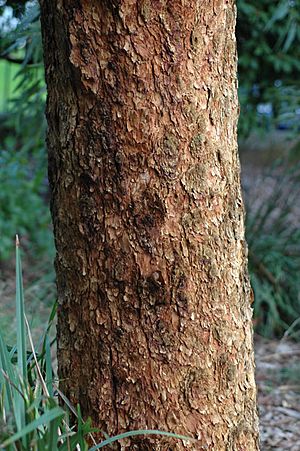Rustyjacket facts for kids
Quick facts for kids Rustyjacket |
|
|---|---|
 |
|
| Corymbia leichhardtii in the Emerald Botanic Gardens | |
| Scientific classification | |
| Genus: |
Corymbia
|
| Species: |
leichhardtii
|
| Synonyms | |
|
|
The Corymbia leichhardtii, often called rustyjacket, Leichhardt's rustyjacket, or yellow jacket, is a type of tree. It grows only in Queensland, Australia. This tree has rough, patterned bark on its trunk and branches. It also has long, curved adult leaves and white flowers. Its fruits are shaped like barrels or urns.
Contents
What Does the Rustyjacket Look Like?
The rustyjacket tree usually grows to be about 15–18 m (49–59 ft) tall. It has a special woody swelling at its base called a lignotuber. This helps the tree regrow if it gets damaged.
Its bark is thick, soft, and has a rough, puzzle-like pattern. The bark can be pale brown, yellow-brown, or orange. You can find this bark on both the main trunk and the branches.
Young rustyjacket plants have leaves that are somewhat round or egg-shaped. These leaves are about 65–165 mm (2.6–6.5 in) long and 25–70 mm (0.98–2.76 in) wide. They grow on a small stem called a petiole.
The adult leaves are thin and a dull grey-green color on both sides. They are shaped like a spear or are slightly curved. These leaves are usually 105–245 mm (4.1–9.6 in) long and 10–38 mm (0.39–1.50 in) wide. Their petioles are about 10–36 mm (0.39–1.42 in) long.
The tree's flower buds grow in groups of seven. These groups are found at the ends of the branches. Each group of buds is on a stalk called a peduncle, which is 6–25 mm (0.24–0.98 in) long. Each individual bud has a short stem, or pedicel, about 4 mm (0.16 in) long.
Rustyjacket trees bloom with white flowers between January and March. After flowering, the tree produces woody fruits. These fruits are shaped like barrels, urns, or flattened spheres. They are about 8–15 mm (0.31–0.59 in) long and 7–13 mm (0.28–0.51 in) wide. The parts that release the seeds stay inside the fruit.
How Did it Get Its Name?
The rustyjacket tree was first officially described in 1906. Frederick Manson Bailey, a botanist, gave it the name Eucalyptus leichhardtii. He wrote about it in the Queensland Agricultural Journal.
Later, in 1995, two other botanists, Ken Hill and Lawrie Johnson, changed its name. They moved it to a different group of trees, calling it Corymbia leichhardtii.
The second part of its scientific name, leichhardtii, honors a famous explorer. This explorer was named Ludwig Leichhardt.
Where Does the Rustyjacket Grow?
The rustyjacket tree grows across a wide area in Queensland, Australia. You can find it from Mareeba in North Queensland all the way south to Salvator Rosa National Park in Central Queensland.
This tree prefers to grow in tropical and subtropical woodlands. These are forests with open spaces and hardy plants. It especially likes sandy soils that are found over sandstone rock.
Is the Rustyjacket Tree Safe?
The Queensland Government has a list of plants and animals. They classify the rustyjacket tree as being of "least concern." This means that the tree is not currently at risk of disappearing. It has a healthy population in the wild.


